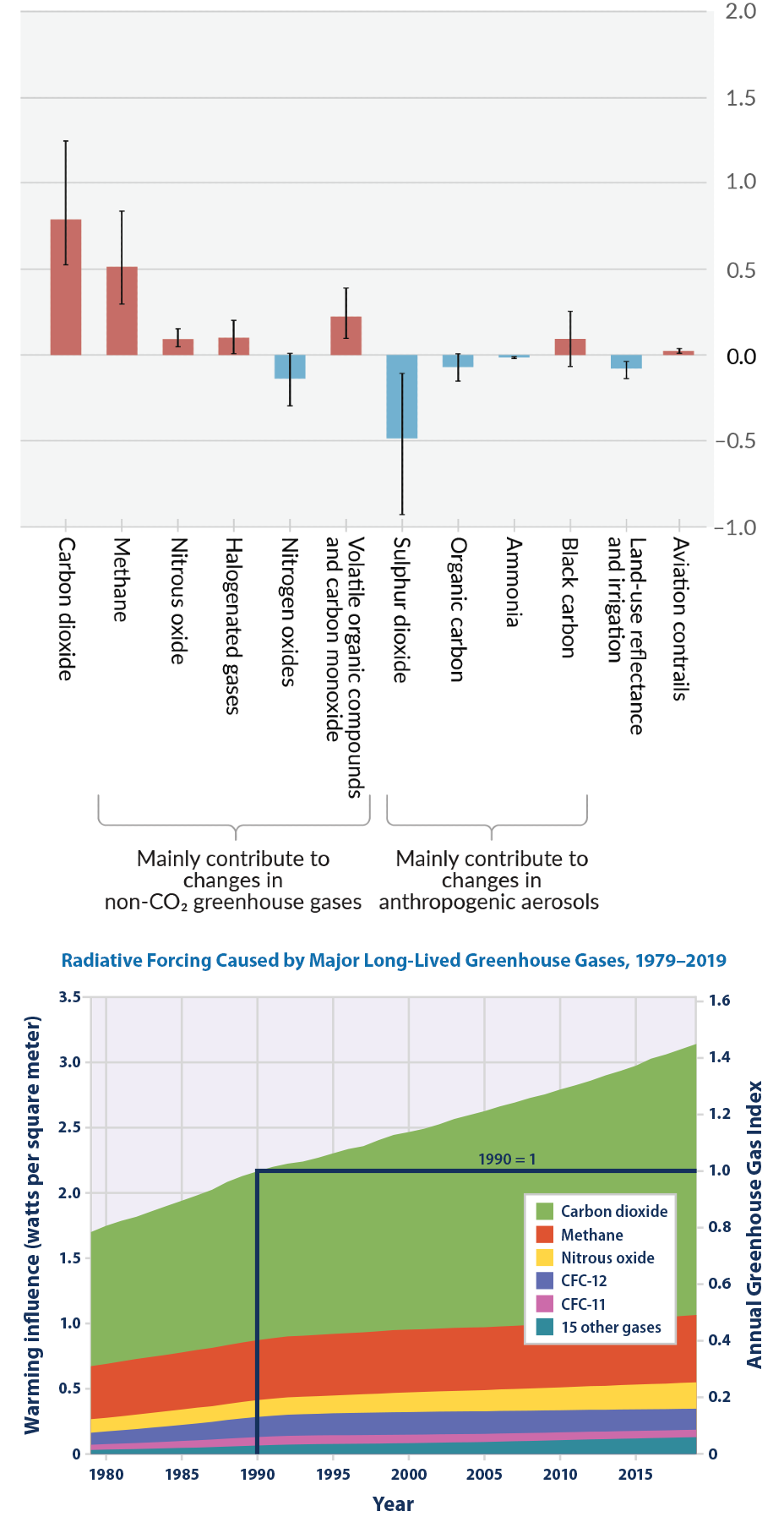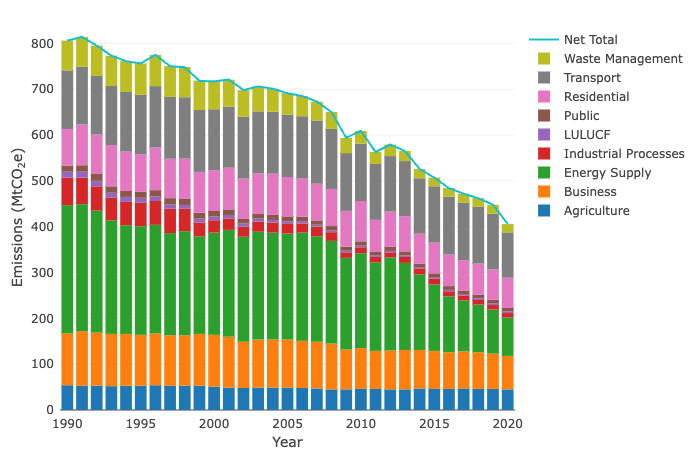
Factually inaccurate: The Daily Mail’s claim that the gasses humans exhale contribute to 0.1% of the UK's greenhouse gas emissions is approximately eight times greater than the value the authors of the study estimated, which was 0.013%. In comparison, we have robust data quantifying the actual factors that fuel global warming, such as emissions from energy, transport, and land use.

REVIEW
CLAIM: New study finds the gasses in air exhaled from human lungs are fueling global warming, contributing 0.1% of greenhouse gasses in the UK. Now scientists say breathing is bad for the environment.
A new scientific study published on 13 Dec. 2023 quantified greenhouse gasses (GHG) emissions from human breathing in the UK and compared the results with other, more well-known known sources of emissions. Dawson et al (2023) found that only 0.05% and 0.1% of the UK’s methane and nitrous oxide emissions, respectively, can be attributed to people breathing. Overall, breathing is estimated to contribute 0.013% of GHG emissions in the UK.
Despite these small percentages, over the next few days and weeks of this study being published, far-reaching online media sources (tabloids) and influential social media accounts misled the public by misrepresenting the study. Among the various headlines reaching millions of readers (a sample is listed further below), the Editorial Board of the New York Post published a piece about the study on 21 Dec. 2023 entitled “Climate fanatics now target BREATHING — proving how much they hate humanity”. Yet, on 13 Dec. 2023, the senior study authors stated explicitly “If you’re looking to reduce your climate impact, don’t hold your breath.”
Multiple tabloids, websites and social media posts used the study to claim, whether sincerely or disingenuously, that breathing is causing and fueling global warming. Whatever the intended angle, these claims grossly misrepresent the study which estimated that humans breathing contribute roughly 1.3 of every 10 000 units of greenhouse gasses (0.013%).
In particular, the Daily Mail (MailOnline) headline “Now scientists say BREATHING is bad for the environment: Gases we exhale contribute to 0.1% of the UK’s greenhouse gas emission” is inaccurate in its entirety. The study and its authors (Dawson and colleagues) never said or implied this, and this percentage value that Daily Mail presented their readers, who then shared it further online, is eight times greater than what the study actually found.
The study’s corresponding author, Dr. Nicholas Cowan of the UK Centre for Ecology & Hydrology, has told Science Feedback that headlines like these are “a misinterpretation of what our study says and its message”. He adds:
“The effect of human breathing would have extremely minimal impact on climate change – the overwhelming issue that should be the focus of efforts to mitigate global warming is the fossil fuels we burn, which our study made clear.”
This claim review will put human breathing as a GHG source in context and outline more precisely what the authors found in comparison to the misleading and inaccurate viral claims which have ensued.
Human breathing is not significantly fueling global warming
There has been an increase in average global temperature of more than 1°C since record keeping began in the second half of the 19th century. Humans have caused all of the observed contemporary global warming. The main factors fueling global warming are clear; they all relate to increasing greenhouse gas emissions which results in the enhanced greenhouse effect. Roughly 79% of GHG emissions are linked to the energy, industry, transport, and building sectors, with the rest coming from the “agriculture, forestry and other land use” category[1].
An enhanced greenhouse effect means the atmosphere can maintain higher temperatures than before the GHG increase. The main GHGs which fuel global warming and which humans are responsible for are carbon dioxide, nitrous oxide, methane, and chlorofluorocarbons. Human activities like burning fossil fuels (for energy, transport, industry, etc.), cutting down forests, using intensive agricultural practices (especially involving nitrogen fertilizers and ruminant livestock), and using products that involve fluorinated gasses continue to raise GHG levels into unknown territories.
Relative to 1750 levels, current atmospheric carbon dioxide has increased by 47% and methane by 156%, far exceeding the scale of natural changes over at least the past 800 000 years between glacial and interglacial periods[1]. Nitrous oxide has also increased by 23% since 1750. Carbon dioxide is considered the most important GHG because it has a long residence time, it is by far the most abundant, and it contributes the most to global warming (Fig. 1). Carbon dioxide causes about two-thirds of the final warming observed; it fuels global warming. Human breathing does not add carbon dioxide to the atmosphere.
Figure 1 – Top: The contributions of different drivers to global warming from the present time period (2010-2019) relative to the time period of 1850-1900. The estimates of warming (red) and cooling (blue) from radiative forcing studies are based on both direct emissions into the atmosphere and their effect, if any, on other climate drivers. Y-axis indicates change in temperature in degrees Celsius (source). Bottom: Radiative forcing caused by major long-lived greenhouse gasses from 1979-2019 based on the change in concentration of these gasses in the Earth’s atmosphere since 1750. Radiative forcing is calculated in watts per square meter, which represents the size of the energy imbalance in the atmosphere. On the right side of the graph, radiative forcing has been converted to the Annual Greenhouse Gas Index (set to a value of 1.0 for 1990), which is a measure of the capacity of Earth’s atmosphere to trap heat as a result of the presence of long-lived greenhouse gasses (source).
During breathing, human lungs oxygenate blood with atmospheric oxygen, in exchange for carbon dioxide which is cleared out from the lungs through exhalations (called gas exchange). However, the carbon dioxide we exhale is not relevant for global warming because it comes from the food we eat, which was produced using carbon dioxide that was already in the atmosphere. The amount of carbon we breathe out balances with the carbon we consume from plants and animals, with a little left to build and maintain our bodies.
Human breathing adds virtually inconsequential amounts of GHGs
The datasets we have for the big GHG emission sources, like those coming from land use or the energy and transport sectors, are robust because of their significance as drivers of global warming. But less important GHG sources receive less scientific attention. For example, we do not have much data on how much methane and nitrous oxide we exhale alongside carbon dioxide.
The methane and nitrous oxide we exhale is newly added to the atmosphere, unlike carbon dioxide. Methanogenic flora in the human gut produce methane and denitrifying bacteria in the gut and oral cavity produce nitrous oxide. Previous studies estimate breathing contributes approximately 0.11% of methane and 0.16% of nitrous oxide emissions globally[2,3]. Although we already know emissions of these GHGs from breathing are very small, we do not have robust data on the exact quantities we exhale and what factors control them (e.g., our diet, age, gender, etc.).
The new study by Dawson and colleagues was conducted to address this research gap and provide more data to compare. Of the 328 breath samples analyzed, they found 31% of people exhaled methane and all emitted nitrous oxide. Extrapolating their results to the full UK population of 68.2 million, they estimated 1.04 gigagrams (Gg) of methane and 0.069 Gg of nitrous oxide are exhaled annually, amounting to 53.9 Gg of CO2e (carbon dioxide equivalent units) in emissions.
In relation to the total emissions of the UK, human breathing is estimated to account for 0.05% of the methane (2051 Gg of methane emitted in 2021) and 0.1% of nitrous oxide (72 Gg of nitrous oxide emitted in 2021). These findings are both smaller than previous study estimates for these gasses at the global scale[2,3].
Dr. Cowan explained to Science Feedback that “Emissions of these gases in human breath is not a new discovery and our own global estimates of emissions from the data are actually lower than previous estimates, which are all cited in the manuscript”. So, the Dawson study actually demonstrated breathing may be even less consequential for global warming than studies have previously thought, which was already very low. And yet, these previous studies did not result in viral tabloid and social media attention.
Overall, when all of the 430 megatonnes of GHGs (CO2e) emitted in the UK in 2021 are considered, not just methane and nitrous oxide, human breathing contributes only 0.013% of that. The annual impact of breathing would be virtually invisible when stacked up alongside all the actual drivers of global warming in the UK. It would take up only 0.0539 Mt CO2e on the y-axis of Figure 2 which extends from 0 to 800 Mt CO2e.
Figure 2 – Summary of historical greenhouse gas emission estimates in the UK from all anthropogenic sources. Total net greenhouse gas (GHG) emissions in 2020 in the UK were 406 Mt CO2e. Carbon dioxide, which is not increased from human breathing, is the dominant GHG emitted, accounting for 79% of emissions in 2020. According to Dawson et al (2023), human breathing in the UK would only take up 0.0539 Mt CO2e on the y-axis of this figure. The estimated uncertainty in total net GHG emissions in 2020 was ± 3%, at a 95% confidence level. The unit “Mt CO2e” refers to the megatonnes of greenhouse gas emissions in carbon dioxide equivalent units (source).
The study has been widely misrepresented; millions of people mislead
Major sources of GHG emissions can be reasonably considered “bad for the environment” in reference to their effects on global temperatures, which can lead to a wide-range of climate change related impacts for the natural world. Slow-onset impacts include sea level rise, salinization, ocean acidification, glacial retreat, land degradation, desertification and loss of biodiversity[4]. Climate change has caused losses and damages on terrestrial, freshwater, and ocean ecosystems worldwide[1]. But as demonstrated above, even though human breathing does increase atmospheric concentrations of two GHGs, methane and nitrous oxide, breathing as a GHG source is virtually inconsequential for global warming (and the “environment”) in comparison to major sources like burning fossil fuels, deforestation, and intensive agricultural practices.
The widely-shared Daily Mail article is not just a misrepresentation of the words of the study’s authors, it is also factually inaccurate. Science reporter Jonathan Chadwick, who had interviewed Dr. Cowan about the study, writes in the Daily Mail article that “Methane and nitrous oxide in the air we exhale makes up to 0.1 per cent of the UK’s greenhouse gas emissions, scientists say.” But the authors never said this. As Dr. Cowan, corresponding author of Dawson et al (2023), explains:
“The total contribution to the UK’s greenhouse gas emissions from human breathing is estimated to be 0.013%, which was clearly communicated to the writer before publication of the article”
Further down in the Daily Mail article, Mr. Chadwick contradicts the headline by stating that the 0.05% of methane and 0.1% of nitrous oxide emissions in the UK estimated to be from human breathing does not equate to “0.1% of the UK’s greenhouse gas emissions”. He writes: “Dr Cowan stresses that each of these percentages relate specifically to these respective gases, not all of the UK’s greenhouse gas emissions as a whole.” We reached out to Mr. Chadwick for comment and will update this review if new information becomes available.
According to Bob Ward (Policy Director at Grantham Research Institute, LSE), the exploitation of the UK’s ineffective press regulation explains the long track record of climate misinformation from the Daily Mail. This would not be the first time the Daily Mail started a wave of inaccurate climate-related claims just from publishing one article. In 2017, a regulatory ruling led to the Daily Mail admitting multiple inaccuracies in an article on global warming, but the false information (including manipulated graphs since taken down from MailOnline) had already been widely shared and repeated in over 150 different articles.
The Dawson study does not state or conclude that breathing is bad for the environment nor that breathing is, or may be, fueling global warming. Despite this reality, the following inaccurate headlines have been published by tabloid press, hyper-partisan websites, and others claiming the study authors say breathing is bad for the environment:
- Now scientists say BREATHING is bad for the environment: Gases we exhale contribute to 0.1% of the UK’s greenhouse gas emissions (Daily Mail (MailOnline))*
- ‘Anti-human’: Scientists claim breathing is ‘bad’ for the environment (Sky News Australia)*
- NEW “SCIENCE” — Humans Breathing Are Bad for the Climate (The New American)
Inaccurate headlines published claiming the study authors say breathing is, or may be, fueling global warming include:
- Humans may be fueling global warming by breathing: new study (New York Post)*
- Study: Humans Contributing to Global Warming by Breathing (Breitbart News)*
- Humans Are Fueling Global Warming By Just Breathing, Study Claims (NDTV)*
- Humans breathing causes ‘global warming’, according to new study (The Post Millennial)*
* indicates a mention, quote, or repetition of the inaccurate 0.1% value originating from the Daily Mail.
The amount of people who were misled by the overall tabloid media’s inaccurate claims about the Dawson study was further increased on social media. Joe Rogan (7.2 million followers), one of the world’s most influential figures on social media (one of Time 100 Most Influential People, 2022), shared the New York Post article on Facebook. Daily Wire personality Michael J. Knowles (1.5 million followers) posted on Facebook the inaccurate claim that the study means humans have to stop breathing, in addition to the inaccurate claim that methane and nitrous oxide “allegedly contribute to global warming”, which has been well-known for decades based on established and fundamental physics[5]. This inaccurate claim was also made by Blaze Media in their article “UK researchers raise alarm that humans are contributing to ‘global warming’ — by breathing”. Pubity (36 million followers), repeated on Instagram the inaccurate claim that “humans may be fueling global warming by breathing”, and the inaccurate claim that “exhaled methane and nitrous oxide, in addition to carbon dioxide, make up around 0.1% of the UK’s greenhouse gas emissions”. This post alone has been liked over 234 000 times as of 12 Jan. 2023.
On the same day the Dawson study was published (13 Dec. 2023), and before the majority of inaccurate and misleading claims appeared in the tabloid media and were shared widely on social media, senior authors Dr. Cowan and Dr. Heal also published an article in The Conversation to help the public understand the study’s main purpose, findings, and implications. In it they stated that the climate change impact of human breathing “pales in comparison to fossil fuel burning and other major sources of emissions”. Dr. Cowan reiterated to Science Feedback: “if you want to be responsible for releasing less greenhouse gasses into the atmosphere, you’d be better off breathing as normal and focusing on other more manageable activities”.
Conclusion
The Dawson study found “extremely minimal” impact of human breathing on climate change in the UK, contributing approximately 0.013% of the total greenhouse gas emissions. The factually inaccurate value of 0.1% published by the Daily Mail has been shared and repeated widely. At no point did the authors say human breathing is bad for the environment and fueling global warming. In reality, the senior study authors have said the contributions of human breathing pales in comparison to fossil fuel burning and other major sources of emissions. We have robust data quantifying the actual factors that fuel global warming, such as emissions from energy, transport, and land use. Tabloid press, hyper-partisan websites, and others have misrepresented the scientists words and the study’s findings and implications, misleading millions of members of the public in the process.
REFERENCES
- 1 – IPCC (2023) Summary for Policymakers. In: Climate Change 2023: Synthesis Report. Contribution of Working Groups I, II and III to the Sixth Assessment Report of the Intergovernmental Panel on Climate Change
- 2 – Polag & Keppler (2019) Global methane emissions from the human body: Past, present and future. Atmospheric Environment
- 3 – Mitsui et al. (1997) Effect of aging on the concentrations of nitrous oxide in exhaled air. Science of the Total Environment
- 4 – Van Der Geest et al. (2021) Slow-onset events: a review of the evidence from the IPCC Special Reports on Land, Oceans and Cryosphere. Current Opinion in Environmental Sustainability
- 5 – Wang et al. (1985). Potential climatic effects of perturbations other than carbon dioxide. In: Projecting the Climatic Effects of Increasing Carbon Dioxide. United States Department of Energy.




